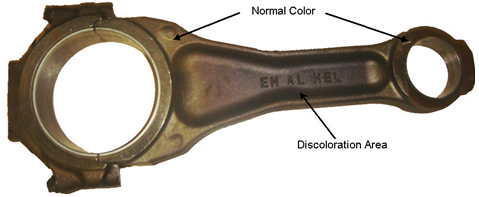Investigation and failure analysis of a diesel generator connecting rod
Main Article Content
Abstract
This article reports a failure analysis of a diesel generator set connecting rod type 3516 B that has operated for 79,678 hours. From visual observation, connecting rod cylinder #10 has changed color in the shank area. This phenomenon may represent many cases of generator failure, so an analysis to identify the root cause of the failure is needed for scientific literature. In this case, fault tree analysis, SEM-EDX, chemical composition, and microstructure testing were performed to obtain more comprehensive results. Through fault tree analysis, we found that the connecting rod damage was caused by compression leakage due to wear on the cylinder liner. Scanning Electron Microscopy (SEM) analysis shows that the piston rod material is discolored due to heat, namely the formation of iron oxide. The heat level received by the connecting rod is around 200 °C. We also found a finely formed, easy-to-clean scale where the thickness ranged from 0.00127–0.008 mm. Finally, EDX analysis showed high levels of iron (Fe) and oxygen (O) confirming that the formation of iron-oxide on the metal surface was due to the influence of heat.
Downloads
Article Details

This work is licensed under a Creative Commons Attribution-NonCommercial 4.0 International License.
References
[2] N. Dayong, S. Changle, G. Yongjun, Z. Zengmeng, and H. Jiaoyi, “Extraction of fault component from abnormal sound in diesel engines using acoustic signals,” Mech. Syst. Signal Process., vol. 75, pp. 544–555, 2016, doi: 10.1016/j.ymssp.2015.10.037.
[3] S. Subekti, M. N. Hidayat, B. D. Efendi, A. Hamid, and A. Murwanto, “Hilbert transform analyzer for mechanical fault detection of vehicle alternators,” Automot. Exp., vol. 3, no. 3, pp. 89–95, 2020, doi: 10.31603/ae.v3i3.3834.
[4] Wilarso, A. Surya, D. N. Adnyana, and Koswara, “Damage Analysis of the Electric Generator Diesel Engine Connecting Rod,” J. Phys. Conf. Ser., vol. 1477, no. 5, 2020, doi: 10.1088/1742-6596/1477/5/052004.
[5] C. Juarez, F. Rumiche, A. Rozas, J. Cuisano, and P. Lean, “Failure analysis of a diesel generator connecting rod,” Case Stud. Eng. Fail. Anal., vol. 7, pp. 24–31, 2016, doi: 10.1016/j.csefa.2016.06.001.
[6] N. P. Doshi and N. K. Ingole, “Analysis of Connecting Rod Using Analytical and Finite Element Method,” Int. J. Eng. Res., vol. 3, no. 1, pp. 65–68, 2013.
[7] P. A. Mas’udi, W. Pracoyo, F. Azharul, and Wilarso, “Analisis Pengaruh Kegagalan Sistem Pendingin Genset Caterpillar 3500 Series,” J. Rekayasa Mater. Manufaktur dan Energi, vol. 2, no. 2, pp. 131–139, 2019, doi: 10.30596%2Frmme.v2i2.3666.
[8] J. Sun et al., “Lubrication performance of connecting-rod and main bearing in different engine operating conditions,” Chin. J. Mech. Eng., vol. 32, no. 1, 2019, doi: 10.1186/s10033-019-0335-9.
[9] E. Febriyanti, “Analisa Kerusakan Connecting Rod Pada Mesin Diesel Kendaraan Bermotor,” J. Sains dan Teknol. Indones., vol. 12, no. 3, pp. 214–219, 2010, doi: 10.29122/jsti.v12i3.858.
[10] S. A. Dmitriev and A. E. Khrulev, “Study of the conrod deformation during piston interaction with liquid in the internal combustion engine cylinder,” J. Mech. Eng. Sci., vol. 14, no. 2, pp. 6557–6569, 2020, doi: 10.15282/JMES.14.2.2020.03.0515.
[11] A. M. Lasitsa, V. G. Churankin, and V. V. Derkach, “Parameter’s Optimization of Surface Plastic Deformation Corrosion-resistant Steel by Computer Simulation,” Mech. Mech. Eng., vol. 22, no. 4, 2018, doi: 10.2478/mme-2018-0079.
[12] V. Bagdasaryan, M. Wagrowska, and O. Szlachetka, “Displacements caused by the temperature in multicomponent, multi-layered periodic material structures,” Mech. Mech. Eng., vol. 22, no. 3, 2018, doi: 10.2478/mme-2018-0063.
[13] K. Bari, A. Rolfe, A. Christofi, C. Mazzuca, and K. V. Sudhakar, “Forensic investigation of a failed connecting rod from a motorcycle engine,” Case Stud. Eng. Fail. Anal., vol. 9, no. February, pp. 9–16, 2017, doi: 10.1016/j.csefa.2017.05.002.
[14] M. Kumar and S. N. Prajapati, “Design, Buckling and Fatigue Failure Analysis of Connecting Rod: A Review,” Int. J. Adv. Eng. Res. Sci., vol. 4, no. 7, pp. 39–44, 2017, doi: 10.22161/ijaers.4.7.7.
[15] M. N. Mohammed, M. Z. Omar, S. Zainuddin, A. Salah, M. A. Abdelgnei, and M. S. Salleh, “Failure analysis of a fractured connecting rod,” J. Asian Sci. Res., vol. 2, no. 11, pp. 737–741, 2009.
[16] A. Strozzi, A. Baldini, M. Giacopini, E. Bertocchi, and S. Mantovani, “A repertoire of failures in connecting rods for internal combustion engines, and indications on traditional and advanced design methods,” Eng. Fail. Anal., vol. 60, no. November, pp. 20–39, 2016, doi: 10.1016/j.engfailanal.2015.11.034.
[17] D. Patil and A. M. Mulla, “Quality Analysis of Connecting Rod for Axial Misalignment : Bend Generated while Machining,” Int. Res. J. of Eng. and Tech., vol. 6, no. 4, pp. 2183–2187, 2019.
[18] G. Prudhvi, G. Vinay, and G. S. Babu, “Cooling Systems in Automobiles & Cars,” Int. J. Eng. Adv. Technol., vol. 2, no. 4, pp. 688–695, 2013.
[19] A. Andoko et al., “Failure analysis of connecting rod,” in 1ST International Seminar on Advances In Metallurgy And Materials (i-SENAMM 2019), 2020.doi: 10.1063/5.0015762.
[20] Y. Huang et al., “Effects of sintering temperature and heat treatment on microstructure and properties of 4605 low alloy steel prepared by powder injection molding,” Fenmo Yejin Cailiao Kexue yu Gongcheng/Materials Sci. Eng. Powder Metall., vol. 24, no. 6, 2019, doi: 10.1080/2374068X.2021.1945807
[21] M. Li, J. Zhou, Q. Chen, and W. T. Kary Chien, “Characterization of pad surface defect by TEM, SEM and EDX,” in 2009 16th IEEE International Symposium on the Physical and Failure Analysis of Integrated Circuits, 2009, pp. 535–537, doi: 10.1109/IPFA.2009.5232589.
[22] Y. Li, “Investigation of Heat Transfer Characteristics on Rod Fastening Rotor,” IOP Conf. Ser. Mater. Sci. Eng., vol. 677, no. 3, 2019, doi: 10.1088/1757-899X/677/3/032032.
[23] J. Pacyna, A. Kokosza, R. Dziurka, “Irreversible temper embrittlement,” Archives of Materials Science and Engineering, vil. 62, no. 2, 2013.

